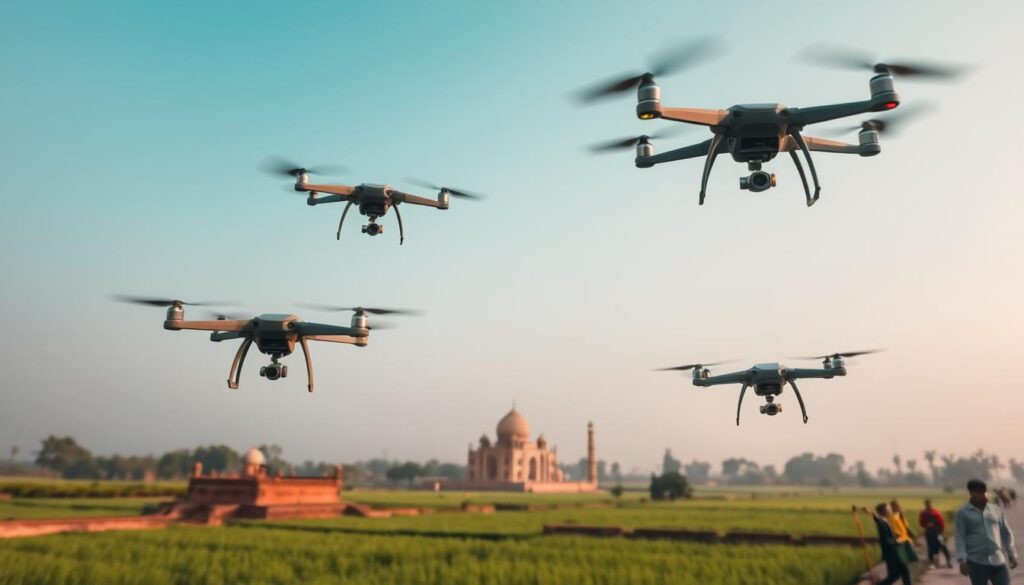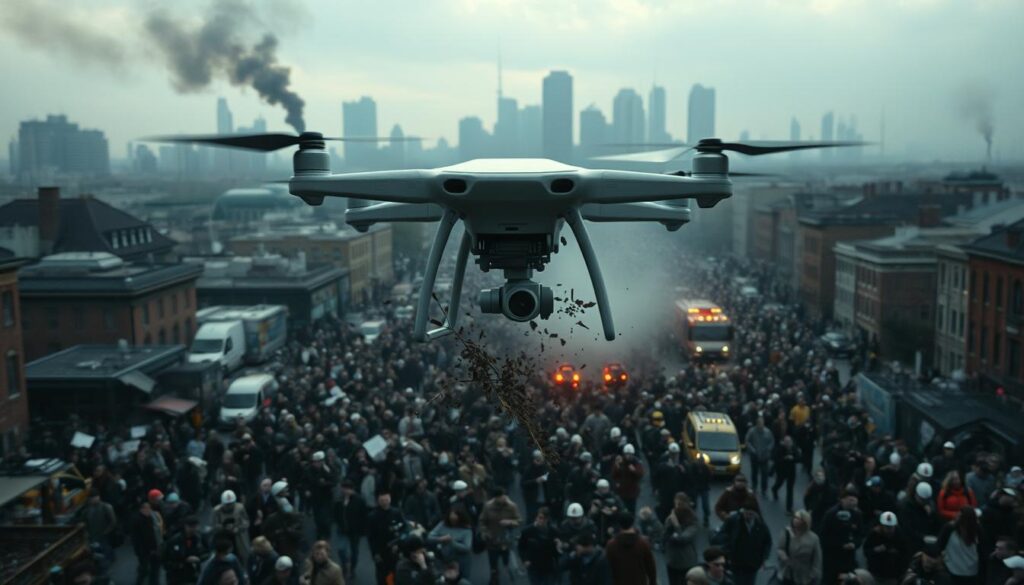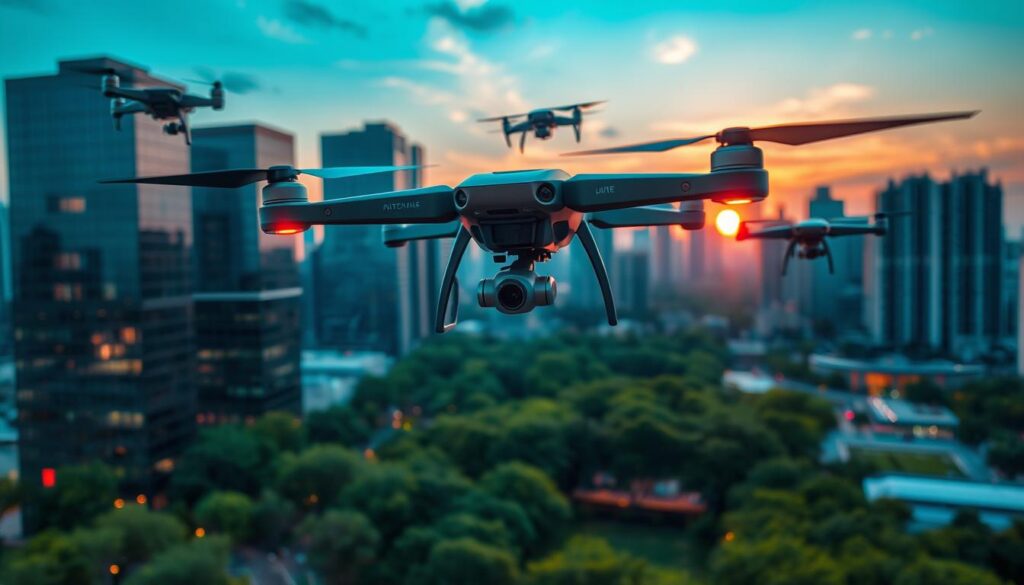If you love drones in India, you’ve probably heard about the “1 1 rule”. It’s a key safety rule from the Directorate General of Civil Aviation (DGCA). This rule helps keep drones flying safely in Indian skies. Let’s explore what the 1 1 rule is, why it matters, and how to follow it.

Key Takeaways
- The 1 1 rule is a safety guideline for drone operators in India.
- It requires drone pilots to maintain a visual line of sight with their drone and keep it within 400 feet of the ground.
- Adhering to the 1 1 rule helps prevent collisions, maintains airspace safety, and ensures compliance with drone regulations.
- Understanding the 1 1 rule is crucial for responsible and legal drone usage in India.
- Violating the 1 1 rule can lead to penalties and legal consequences for drone operators.
Understanding the 1 1 Rule for Drones
The 1 1 rule for drones in India is key for safe drone use. It says drone pilots must always see their drone and keep it within 1 kilometer (1 mile). This rule is set by the drone 1 1 rule definition.
Defining the 1 1 Rule
The 1 1 rule for drones is simple but vital. It lets pilots keep an eye on their drone at all times. This rule stops drones from crashing or causing trouble when they’re out of sight.
Why the 1 1 Rule is Important
The importance of 1 1 rule for drones is clear. It keeps drone flying safe and controlled. By seeing their drone and not flying too far, pilots can dodge problems and follow rules. This 1 1 rule is key in India, where drones are getting more common.
“The 1 1 rule for drones is a simple yet essential guideline that ensures drone pilots can effectively monitor and control their aircraft throughout the flight.”
Following the 1 1 rule for drones lowers risks in drone flying. It builds a safe culture in the drone world. By sticking to this rule, pilots in India help the drone industry grow safely, keeping everyone safe.
Implications of Violating the 1 1 Rule
Not following the 1 1 rule for drones can lead to serious consequences. Drone users who violate this rule may face penalties, like fines and legal action. It’s key to know and stick to the 1 1 rule for safe and legal drone flying in India.
One big penalty for breaking the drone 1 1 rule is money. Those caught can face big fines, from a few thousand rupees to lakhs. These fines aim to stop reckless drone use and encourage responsible flying.
Ignoring the 1 1 rule can also lead to legal trouble. Drone users might face criminal charges or even jail. These legal problems can harm a person’s record and reputation, making following rules very important.
The effects of breaking the 1 1 rule for drones aren’t just for the operator. Bad drone use can risk public safety, causing accidents or security issues. By following the 1 1 rule, drone users help keep everyone safe and use drones responsibly.

In short, the penalties for not following the drone 1 1 rule are serious, both in money and law. Drone users must understand and follow this rule to avoid legal problems and ensure safe drone use in India.
What is the 1 1 Rule for Drones?
The 1 1 rule for drones in India is key for safe flying. It has two main parts. These parts help keep drones safe and prevent accidents.
Breaking Down the Rule
The first part of the rule is to always see your drone with your eyes. You can’t use binoculars or other tools to see it. This rule helps you know where your drone is and avoid problems.
The second part says your drone must stay within 1 kilometer (or 1 mile) of you. This rule helps you control your drone better. It also lets you react fast if something unexpected happens.
Following the 1 1 rule for drones is important. It makes sure you’re flying safely. It also shows you care about flying responsibly.
Exceptions to the 1 1 Rule
The 1 1 rule is the standard for drone operations in India. But, there are exceptions to this rule. Drone operators can fly their drones beyond the 1 kilometer (1 mile) limit or without direct visual line of sight in special cases. This section will look at these exceptions and what’s needed to get approval.
One exception is for search and rescue operations. Drone pilots can fly beyond 1 kilometer if it’s needed to find and help people in danger. Drone use in disaster relief efforts also gets an exception from the 1 1 rule.
Another exception is for drone flights for scientific research and development. Drone operators can get special permission to fly beyond 1 kilometer if it’s for a legitimate scientific need. This could be for aerial surveying, atmospheric monitoring, or tracking wildlife.
- Exceptions may be granted for search and rescue operations
- Drone use in disaster relief efforts can also be exempted
- Flights for scientific research and development may be permitted to exceed the 1 1 rule
To get an exception, drone operators must apply to the right authorities. They need to explain the specific reasons and justification for their flight. Each application is reviewed carefully, considering the drone’s abilities, the mission’s nature, and the risks.

Knowing the exceptions to the 1 1 rule and how to get approval helps drone operators in India. They can use their drones in more ways safely and responsibly.
Best Practices for Adhering to the 1 1 Rule
To follow the 1 1 rule for drones in India, it’s key to fly responsibly. By following important guidelines, you can have fun with your drone while staying within the law.
Always keep your drone in sight. This means you should see it with your eyes, without binoculars or other tools. Keeping it in sight is crucial for safe and legal flying.
Also, make sure your drone is no more than 1 kilometer (1 mile) away. This rule stops your drone from flying too far and losing sight. To fly responsibly, plan your flights well and avoid places where you might lose sight of your drone.
| Tip | Description |
|---|---|
| Visual Line of Sight | Keep your drone within your direct line of sight at all times. |
| Distance Limitation | Maintain a maximum 1 kilometer (1 mile) radius from your location. |
| Responsible Flight Planning | Carefully plan your drone flights to avoid areas where you may lose sight of your aircraft. |
By following these tips, you can enjoy drone technology safely and legally in India. These guidelines will make you a responsible and safe drone user.
Conclusion
The 1 1 rule for drones is key for safety in India. It helps you fly drones safely and responsibly. Following this rule is vital for drones to grow and be accepted in India.
Key points of the 1 1 rule include seeing your drone at all times and keeping it 450 meters away. You also need to follow other rules to avoid accidents. This rule keeps you safe and respects the privacy of others.
Following the 1 1 rule is very important in India. As drones become more common, following these rules helps create a safe drone culture. This opens the door for more innovation and use of drones in different areas. By focusing on safety and following rules, you help the drone industry in India grow responsibly.
FAQ
What is the 1 1 rule for drones?
The 1 1 rule is a key safety rule for drone users in India. It means you must always see your drone and keep it within 1 kilometer (1 mile) of you.
Why is the 1 1 rule important?
This rule is vital for safe drone use. It helps avoid accidents and keeps drone pilots in control. It ensures they know where their drone is at all times.
What are the consequences of violating the 1 1 rule?
Breaking the 1 1 rule can lead to big problems. You might get fined or even face legal trouble. It’s important to follow this rule to fly drones safely and legally in India.
Can drones ever fly beyond the 1 kilometer (1 mile) limit?
Yes, there are times when drones can fly farther than 1 kilometer (1 mile). In some cases, you might get permission to fly further or without always seeing your drone.
How can I ensure I’m following the 1 1 rule for drones?
To stick to the 1 1 rule, follow some simple steps. Always keep your drone in sight, stay within the 1 kilometer (1 mile) limit, and use other safe flying practices.